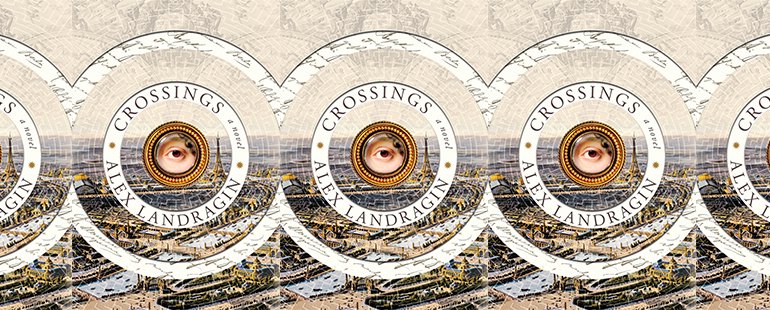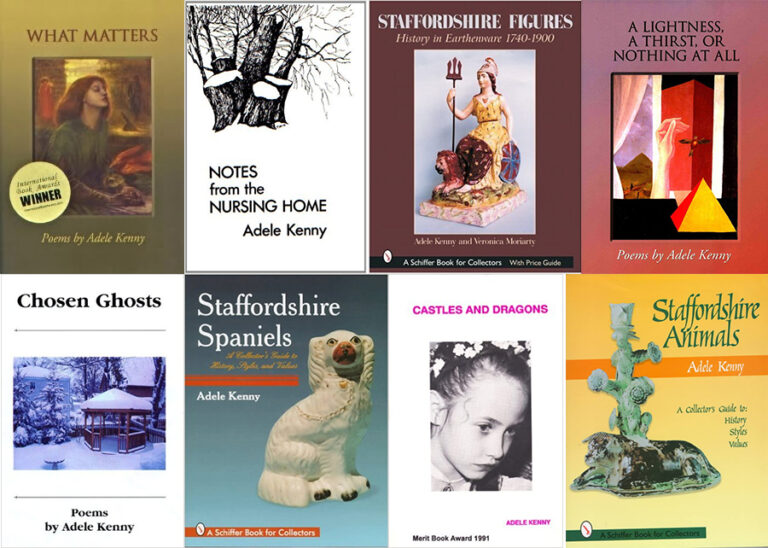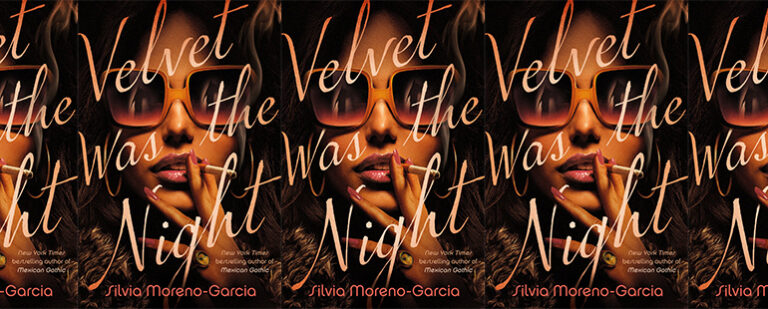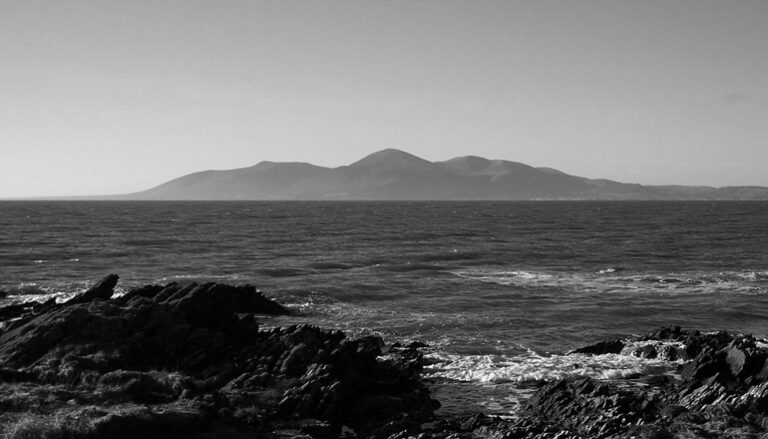“One only reads a novel for the first time once”: An Interview with Alex Landragin

I used to stay up with a flashlight reading Choose Your Own Adventure Books under the covers of my water bed, flipping back from the “you have died” page until I made it through to a more satisfying end. In 2020, authors are still toying with the notion that a reader brings life to a book, and that authors can directly manipulate their reading experiences with new structures. Take, for example, Percival Everett’s latest novel, Telephone, which in a May interview with James Yeh at the New York Times was revealed to have been printed in three separate editions, identifiable only by slight cover design variations; each edition supplies a unique ending. Alex Landragin’s Crossings, out this week, is similar in its structural unconventionality, allowing the reader to choose if they’d like to read it straight through or according to a unique sequence of alternative pagination, which completely changes the temperament of the novel as a whole.
As an opening catalyst to the book, a rare and newly discovered manuscript by Charles Baudelaire goes up for auction, whose first sentence is revealed: “As I write these words, it occurs to me that I have never known a tale to be so beyond belief as that which I am about to relate to you, dear girl.” Crossings is framed by the idea that this rare book was never meant to be seen. Sent to a bookbinder for ultra-special treatment by a Baroness then abandoned in the wake of her death, it was never even supposed to be opened except in the rebinding process. But now, with the Baroness gone, the bookbinder cracks open this rarity, eager to see what it holds. The book, called Crossings, consists of three sections: the first, an uncatalogued story handwritten by Charles Baudelaire; the second, a 1940s French noir thriller narrated by Walter Benjamin that has its roots in Benjamin’s famous critique of historicism, “On the Concept of History”; and the third, the autobiography of a seemingly immortal enchantress that is based on a story Landragin heard in a class taught by Melbourne poet Chris Wallace-Crabbe. And while the origin of how this three-part text came together is part of the novel’s mystery, the death of the book’s owner puts it into our hands.
Landragin’s Crossings’s preface ends by giving us a choice: the book can be read in paginated order, moving through each of the three books within in turn, or it can be read in what the bookbinder’s wife has dubbed the “Baroness Sequence,” which leads the reader through all three books simultaneously, following notes within page footers à la the Choose Your Own Adventure series. Reading the text in this way means toggling between the stories of Benjamin escaping from German-occupied France during WWII, Baudelaire contemplating an alternate metaphysical existence while trying to complete his handwritten story, and the tale of Alula and Kaohu, the characters whose story explains the origin, principles, and outcomes of “crossing.” These are the main components of each story in Crossings, though the novel is sweeping and complex, making any attempt to condense its complicated plots nearly impossible. Really, the idea of “crossing” is the true crux of the novel.
“Crossings” are said to have originated in Oaeetee, an isle where “they practiced a strange kind of metempsychosis of the living, if you will.” Essentially, one stares into the eyes of another in order to take their place. Benjamin gives us further details on the process, explaining how “during a crossing, one enters into a body and inherits its capacities and incapacities, its appetites and proclivities. But one also enters into a mind.” The decision to cross is often made in defiance or fear of death, and it is an incredibly intimate act. As described for the first time to Baudelaire: “You who are a poet, do you not see that the power of the crossing is within every human soul? Whenever you look another person in the eyes, do you not feel within the pit of your stomach a kind of forward yearning so powerful that it frightens you?” Crossings are what set the novel in a variety of cultures, locations, and time periods; Landragin’s roots as a French-Armenian-Australian writer who has lived in Paris, Los Angeles, New Orleans, Marseille, and Australia make this blending of geography and culture tremendously clear and add a global identity missing from many contemporary novels that tend to bathe in their singular cultural references.
The characters—and thus the story—of Crossings are able to sift through time because they have crossed, dumping one body for the next, wending their way through multiple lifetimes and cultures. But while a large portion of the novel’s joy is to simply read their crossing routes, which begin at the isle of Oaeetee and continue through World War II, Landragin also puts other intriguing through-lines into play. For instance, the albatross features in numerous places as a marker or hint of a crossing, alongside its typical Samuel Taylor Coleridge symbolism of death and bad luck. Reincarnation becomes a discussion point too, many of the novel’s characters relating its differences and similarities to the notion of a living transfer. Bibliophilia serves as yet another guidepost, from the preface’s careful consideration of bookbinding and bleeding all the way through to The Baudelaire Society’s private, one-of-a-kind library. Charles Baudelaire’s relationship with the Haitian actress Jeanne Duval is also explored, as a kind of new lens on colonialism—reversing our typical approach by giving Duval the greatest voice, and, with “crossings,” allowing characters to share or meld their viewpoints, as people often struggle to do. All of these elements deepen with intricacy a novel that is already profound and complex in its narrative, almost giving the reader the intimacy of a crossing for themselves, allowing us to inhabit the bodies of these characters and their distinct cultures, time periods, and emotional landscapes.
Landragin has genuinely completed a feat on two planes—he’s written a fascinating novel with gobs of forward momentum while also structuring the entire text in such a way that it can be read with two different paginations. Crossings presses the reader to come to terms with what it would mean to inhabit another body, to cross from one time period or culture to another, and to leave behind what we once knew in order to better understand others—where they come from, who they are, and the cultures and upbringings that made them who they are. Crossings toys with the limits of time and space, pulling us through eons and metaphysical worldbuilding with grace, aplomb, and mystery. As Baudelaire puts it in that rare, handwritten story: “As I write these words, it occurs to me that I have never known a tale to be so beyond belief as that which I am about to relate to you, dear girl. Yet nothing I have written has ever been so true. Paradox, all is paradox.”
I recently spoke with Landragin about Baudelaire, bibliophilia, metafiction, Benjamin, cultural exchange, the reader’s choice, and reincarnation.
J.A. Tyler: It seems in writing a novel like Crossings, you’d have to be not only a first-rate lover of but also a researcher of Baudelaire. How well do you know his life and writing? It seems like the novel, in some way, is a fan letter or public display of admiration for his work.
Alex Landragin: Thank you, but I consider myself more an admirer of his achievement and legacy. As a writer of French origin, it’s impossible to be unaware of Baudelaire, but what drew me to him in this instance was his relationship with Jeanne Duval and his (very different) relationship (across time) with Walter Benjamin. I’d been introduced to Jeanne Duval, a Black woman of uncertain (though probably Haitian) origin, by Angela Carter’s short story “Black Venus.” But when I first conceived the novel, I was drawn to the book’s two other stories. The first of these is the story of the death of Walter Benjamin—not just the famous lost manuscript, but his bearing witness to the, at the time, calamity of the capitulation of French democratic republicanism to Nazism. The second and more important story I was initially drawn to was one that had been knocking about in my head for more than two decades: that of a fictional island whose inhabitants can “cross” between bodies, a story about colonialism that allowed me to reverse the duality of center and periphery. It struck me that Charles and Jeanne’s relationship could be the glue that bound these two stories together. The character Alula therefore became the “angel of history” that Benjamin wrote about in his late essay “Theses on the Concept of History,” forever looking back while being drawn forward, but as seen through an explicitly post-colonial lens.
So being only a casual reader of Baudelaire, I had to do a deep dive into his work and life. Thankfully he wasn’t prolific—his writing is contained in a single volume, although it is a varied and rich one. I also read Joanna Richardson’s excoriating biography [Baudelaire: The Life of Charles Baudelaire]. Baudelaire’s enduring legacy is the romantic urban countercultural aesthete/flâneur that was a dominant strain of Western literature and art for more than a century after his death, one we still catch glimpses of today in figures like Patti Smith and Nick Cave. But this aesthetic’s relationship with the colonial other often depended on an exclusionary exoticization. That dynamic is reflected in the relationship between Baudelaire and Duval.
JAT: There is so much in the novel about the nature and quality of books as physical objects. Are you a bibliophile? How much research or personal experience did it take to bring out the details you have on book-binding, manuscripts, and book collecting?
AL: Long-term nomadism has decimated my book collection and made me quite pragmatic about books as objects. So I’m not really a bibliophile myself. But like most writers I venerate books and I’m interested in how they function within the economies of art and knowledge. The novel’s fascination with the book-as-object reflects a Benjaminian interest in the contradiction of the book as, on the one hand, a talismanic, even fetishistic object with an aura (like [Benjamin’s] The Arcades Project), and on the other as an endlessly reproducible industrial artefact. Crossings isn’t so much a work of bibliophilia as the symptom of an anxiety about the passing of the prestige of books, literature, and art. In that sense, the book is both a work of nostalgia and a call to arms.
When I launched into this book, I felt compelled to move to Paris to research it. I ended up spending about ten months there in two stints. I arrived there with the novel’s three stories already in mind, but not knowing how I might weave them together. Paris gave me everything I needed. There still exists in Paris a culture of artisanal bookbinding, so much so that there is a technical high school devoted to the métier. I also became obsessed with the city’s remarkable library network, from the extraterrestrial Bibliothèque Nationale to the fascinating little Police Library to the ravishing Bibliothèque Forney, an art and design library housed in an eighteenth-century château in the Marais. And I became interested, of course, in the city’s extended cultural economy, from the Drouot auction house to the flea markets and of course the bouquinistes, the second-hand booksellers, who have been selling books in green tin boxes propped up on the walls along the river since medieval times. Among the fascinations of Paris, especially for a cultural critic like Walter Benjamin or later figures like [Michel] Foucault and [Pierre] Bourdieu, is its combination of geographical compactness and its hoarding of information. It is the perfect place to study the flow of ideas.
JAT: The framing of Crossings is that of a book within a book. Then there are three separate stories within that book, and a wealth of smaller tales within each of those. How did this structure originate, and was it difficult to tend?
AL: The origin story of the novel goes back to when I was in [my] first year [of] college, already determined to be a writer. I took a creative writing class with the Melbourne poet Chris Wallace-Crabbe, who told us one morning about a story he’d just read. In almost as many words, he said it was about an island whose inhabitants can cross from one body to another. In the story, the island is visited by a European ship for the first time. By the end of the story, the reader isn’t sure who has gone and who has stayed behind. This story blew my mind at the time. It was the story that I wanted to write, but I felt like somebody had got there first, that I must find other subject matter to write about. So I tried to forget it—only I couldn’t. I even got in touch with that teacher again, years later, to ask him about the story. He told me he couldn’t even remember having read it.
I am a migrant. I was born in France and migrated to Australia with my family as a child. But to complicate matters, I have two cultural backgrounds, French and Armenian. And to complicate matters even further, my family moved to the US when I was eighteen, and for years I straddled Australia and the US. As a reader, this meant I was drawn to émigré and exiled writers: [Joseph] Conrad, [W. G.] Sebald, [Vladimir] Nabokov, [Roberto] Bolaño, [Georges] Perec. As a writer, it meant that I struggled for a long time to come up with a literary identity and a subject matter I was passionate about. I didn’t care for much of what I wrote. When I was nearing forty, I started a blog called the Daily Fiction Project, where I blogged a story a day, intending it to continue for a year. By month eight, I was getting desperate, so I wrote my own version of that lost story I’d been told about decades earlier, acknowledging its mysterious origin at the end of the story. The next day I had an epiphany: the end of that story, when the ship sails away, is the beginning of a much bigger and more interesting story.
At the time, I was also very interested in Walter Benjamin’s final essay, “Theses on the Concept of History.” Of course, I was aware of the manuscript he was carrying at the time of his death that was subsequently lost. I toyed with the concept of bringing the two stories together. Benjamin wrote extensively about Charles Baudelaire, and I was already interested in Jeanne Duval, and it seemed possible to glue the two stories together with Charles and Jeanne. I sensed this would create some space for me to explore some compelling themes. The title, preface, and the final scene came to me practically at the beginning, as did the two as-yet-unwritten sequels. But the dual reading-sequence structure didn’t come until much, much later.
JAT: At the end of the preface, readers are given the option to either read the book straight through or to read it according to the Baroness Sequence. How much does each reading change the novel? Which way would you encourage a reader to go?
AL: One of the many things I like about the dual reading-sequence structure is that no one will ever be able to truly compare the experience of reading the novel one way with that of reading the other, because one only reads a novel for the first time once. Obviously you can read it a second time, but the second time is always informed by the first time. And as the writer, I’ll never truly know what it’s like to read the novel. I’ve been told that they feel like completely different books.
I’d already written a complete draft when I came up with the idea of a second sequence. The original, single sequence was what is now the Baroness sequence. I was living in Los Angeles at the time, surrounded by screenwriters, and one of the reasons the idea appealed to me was as a reaction against the often overly rigid and formulaic ways screenwriters are trained to think about story.
For all the caveats, I have some hunches. Reading the Baroness Sequence is a headier, more vertiginous, more challenging, and I suspect more rewarding experience, with a slightly better ending. The stories ricochet off one another more. The conventional sequence, where the stories are read separately, is a slower burn. It’s perhaps a little less emotional, a little more cerebral. The connections between stories reveal each other more slowly. Many readers prefer the conventional sequence. Of the enthusiastic readers I’ve spoken with, opinion seems to be split down the middle, which pleases me because it shows me I’ve done my job.
I’d encourage readers to read the book quickly, perhaps on holiday or in quarantine, and if so to read it in the Baroness Sequence, if only because that reading experience is truly unique: as the reader, you’re completely unable to keep your bearings. You can’t tell where you are in the book. You can’t count pages. The bookmark doesn’t tell you how far there is to go. All you can do is keep reading. In that sense, it’s true to life.
JAT: Do you believe in something like a “crossing” or a reincarnation?
AL: Yes, of course I do. In art, in books, in language, in memory and especially, above all, in love, crossings take place all the time. In fact, that’s most of what life is, a series of crossings and reincarnations. But there are limits to it. Alas, we only have the one body and the one life.


